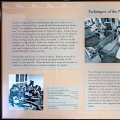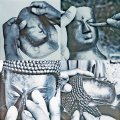Patan Museum (Nepal): photo 209
Photo 209 of 212 in Gallery: Patan Museum (Nepal)

Image title: The Metallurgical Arts in Nepal
Description of the photo
The Metallurgical Arts in Nepal—The skill in transmuting metal into superb works of piety—and art—such as exemplified in this museum’s exhibits is an outstanding Nepalese achievement. It has been the object of foreign esteem since at least the seventh century A.D. when a Chinese diplomat commented on it in his memoirs. When and from whom artists and craftsmen learned these skills is unknown but they were most likely introduced by way of the Indian sub-continent. Some three millennia B.C. at urban centers such as Mohenjo Daro images were already being cast by what appears to be the highly complex "lost wax" technique and by the second century A.D. there are Indian literary references to it.
In the Kathmandu Valley a well-developed stone sculpture tradition was already in place by the second century but if paralleled by metal sculptures, as seems probable, none this early has been found. The oldest now known is a superb image of the Buddha cast in this very city in A.D. 591 but such perfection must rest on far older antecedents. The technique of embossing sheet metal with relief design (repoussé) is at least equally old in Nepal as attested by a repoussé image made in A.D. 607 to replace one "which had become dilapidated with the passage of time."
In a tradition that continues in Patan today, there are no large-scale foundries or factories. Metalworking is a small-scale family affair of certain Newar castes, who conduct it at home. To the mid-eighteenth century, cult objects literally poured from these workshops, not only to satisfy local needs, Hindu and Buddhist, but also foreign ones. In the thirteenth century at the request of Kubilai Khan, the renowned Mongol warlord, a deputation of some eighty Newar artists went to Tibet and their leader, Aniko, went on to fame as head of the imperial workshops in what is now Beijing. In succeeding centuries Tibetan Buddhists turned particularly to Nepalese metallurgists for cult objects, fashioned either in Nepal or in Tibet by domiciled Newars. The reduced patronage and curtailed Tibet trade that followed Nepal’s dynastic change in 1768/69 resulted in diminished production. Today even though the metallurgical arts largely subserve the tourist industry, skilled artist-craftsmen continue to fulfill many commissions as of old, especially for foreign patrons who are practitioners of Buddhism. Among them, for example, are the descendants of Kuber Singh Shakya of nearby Uku-bahal, a mid-twentieth-century artist of renown whose splendid works sanctify numerous shrines in Nepal, Tibet and Bhutan.
[Photograph center]—
Shakyamuni, the Historical Buddha [Nepal, 12th century, copper alloy, gilt.]—This superb example of Nepalese metalcraft depicts the historical Buddha in his most typical pose, seated in meditation, one hand in his lap, the other pendant in the earth-witness gesture. The original statue is exhibited in Gallery E. The head of this image was reproduced to illustrate the lost wax casting process.
Gallery information:
The Patan Museum is located on the Durbar square of Patan (Lalitpur/Lalitapura, Kathmandu, Nepal) which is associated Keshav Narayan Chowk (Keshavnarayan)—a form of Lord Vishnu. Being listed as a World Heritage Site, the whole of Durbar square is filled with exquisite temples, sculptures and other ancient structures, of which the ancient history history can be traced to the Malla Kings of Lalitpur. It is an important site for both Buddhism and Hinduism.
Photo details:
Date: 2019-12-02
Camera: SONY ILCE-6400
Exposure: 1/160
Aperture: f/4
ISO: 640
Focal length: 18mm
High resolution:
Download file
Size: 4.14 MB
Resolution: 4064 x 2000
© Photograph by Gabe Hiemstra.
License: CC BY-NC-ND 4.0

